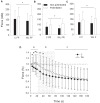Motor Unit Force Potentiation and Calcium Handling Protein Concentration in Rat Fast Muscle After Resistance Training
- PMID: 34054571
- PMCID: PMC8160384
- DOI: 10.3389/fphys.2021.652299
Motor Unit Force Potentiation and Calcium Handling Protein Concentration in Rat Fast Muscle After Resistance Training
Abstract
Post-tetanic potentiation (PTP) of force depends on intramuscular Ca2+ levels and sensitivity and may be affected by fatigue. The aim of this study was to determine the ability of isolated fast fatigue-resistant (FR) and fast-fatigable (FF) motor units (MUs) to potentiate force evoked with single and 40-Hz electrical stimulation after 5 weeks of voluntary weight-lifting training. Tetanic contractions evoked by gradually increasing (10-150 Hz) stimulation frequency served as conditioning stimulation. Additionally, the concentration of myosin light chain kinase and proteins engaged in calcium handling was measured in rat fast medial gastrocnemius muscle. After the training, the potentiation of twitch force and peak rate of force development was increased in FF but not FR MUs. Force potentiation of 40-Hz tetanic contractions was increased in both fast MU types. After the training, the twitch duration of FR MUs was decreased, and FF MUs were less prone to high-frequency fatigue during conditioning stimulation. Muscle concentration of triadin was increased, whereas concentrations of ryanodine receptor 1, junctin, FKBP12, sarcoplasmic reticulum calcium ATPase 1, parvalbumin, myosin light chain kinase, and actomyosin adenosine triphosphatase content were not modified. After short-term resistance training, the twitch contraction time and twitch:tetanus force ratio of FR MUs are decreased, and PTP ability is not changed. However, PTP capacity is increased in response to submaximal activation. In FF MUs increase in PTP ability coexists with lesser fatigability. Further work is required to find out if the increase in triadin concentration has any impact on the observed contractile response.
Keywords: calcium release; excitation contraction coupling; fatigue; muscle fibers; strength training; window of opportunity.
Copyright © 2021 Łochyński, Kaczmarek, Grześkowiak, Majerczak, Podgórski and Celichowski.
Conflict of interest statement
The authors declare that the research was conducted in the absence of any commercial or financial relationships that could be construed as a potential conflict of interest.
Figures





Similar articles
-
Contractile properties of motor units and expression of myosin heavy chain isoforms in rat fast-type muscle after volitional weight-lifting training.J Appl Physiol (1985). 2016 Oct 1;121(4):858-869. doi: 10.1152/japplphysiol.00330.2016. Epub 2016 Aug 18. J Appl Physiol (1985). 2016. PMID: 27539495
-
Changes in the contractile properties of motor units in the rat medial gastrocnemius muscle after one month of treadmill training.Acta Physiol (Oxf). 2008 Aug;193(4):367-79. doi: 10.1111/j.1748-1716.2008.01848.x. Epub 2008 Feb 22. Acta Physiol (Oxf). 2008. PMID: 18298635
-
Concomitant effects of fatigue and potentiation in rat medial gastrocnemius fast motor units.Sci Rep. 2025 Jul 2;15(1):23085. doi: 10.1038/s41598-025-07607-0. Sci Rep. 2025. PMID: 40604012 Free PMC article.
-
Influence of exercise and training on motor unit activation.Exerc Sport Sci Rev. 1987;15:95-151. Exerc Sport Sci Rev. 1987. PMID: 3297731 Review.
-
Coexistence of potentiation and fatigue in skeletal muscle.Braz J Med Biol Res. 2000 May;33(5):499-508. doi: 10.1590/s0100-879x2000000500003. Braz J Med Biol Res. 2000. PMID: 10775880 Review.
Cited by
-
Effect of home-based hot bathing on exercise-induced adaptations associated with short-term resistance exercise training in young men.Physiol Rep. 2025 Feb;13(3):e70188. doi: 10.14814/phy2.70188. Physiol Rep. 2025. PMID: 39887948 Free PMC article.
-
Walking, Running, Swimming: An Analysis of the Effects of Land and Water Aerobic Exercises on Cognitive Functions and Neural Substrates.Int J Environ Res Public Health. 2022 Dec 6;19(23):16310. doi: 10.3390/ijerph192316310. Int J Environ Res Public Health. 2022. PMID: 36498383 Free PMC article. Review.
References
-
- Celichowski J., Grottel K. (1992). The dependence of the twitch course of medial gastrocnemius muscle of the rat and its motor units on stretching of the muscle. Archiv. Ital. Biol. 130 315–324. - PubMed
LinkOut - more resources
Full Text Sources
Other Literature Sources
Research Materials
Miscellaneous

